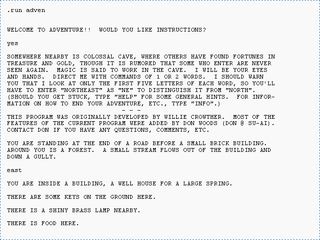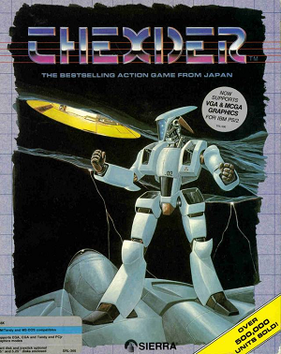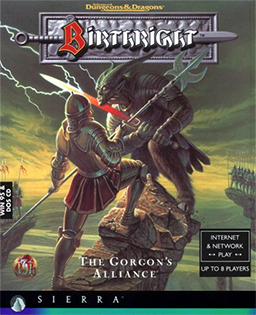
Zork is a text adventure game first released in 1977 by developers Tim Anderson, Marc Blank, Bruce Daniels, and Dave Lebling for the PDP-10 mainframe computer. The original developers and others, as the company Infocom, expanded and split the game into three titles—Zork I: The Great Underground Empire, Zork II: The Wizard of Frobozz, and Zork III: The Dungeon Master—which were released commercially for a range of personal computers beginning in 1980. In Zork, the player explores the abandoned Great Underground Empire in search of treasure. The player moves between the game's hundreds of locations and interacts with objects by typing commands in natural language that the game interprets. The program acts as a narrator, describing the player's location and the results of the player's commands. It has been described as the most famous piece of interactive fiction.

Colossal Cave Adventure is a text-based adventure game, released in 1976 by developer Will Crowther for the PDP-10 mainframe computer. It was expanded upon in 1977 by Don Woods. In the game, the player explores a cave system rumored to be filled with treasure and gold. The game is composed of dozens of locations, and the player moves between these locations and interacts with objects in them by typing one- or two-word commands which are interpreted by the game's natural language input system. The program acts as a narrator, describing the player's location and the results of the player's attempted actions. It is the first well-known example of interactive fiction, as well as the first well-known adventure game, for which it was also the namesake.

Akalabeth: World of Doom is a role-playing video game created in 1979 for the Apple II by Richard Garriott, and published by California Pacific Computer Company in 1980. Garriott designed the game as a hobbyist project, which is now recognized as one of the earliest known examples of a role-playing video game and as a predecessor of the Ultima series of games that started Garriott's career. Garriott is the sole author of the game, with the exception of title artwork by Keith Zabalaoui.

Temple of Apshai is a dungeon crawl role-playing video game developed and published by Automated Simulations in 1979. Originating on the TRS-80 and Commodore PET, it was followed by several updated versions for other computers between 1980 and 1986.
Fueled by the previous year's release of the colorful and appealing Pac-Man, the audience for arcade video games in 1981 became much wider. Pac-Man influenced maze games began appearing in arcades and on home systems. Pac-Man was the highest grossing video game for the second year in a row. Nintendo's Donkey Kong defined the platform game genre, while Konami's Scramble established scrolling shooters. The lesser known Jump Bug combined the two concepts into both the first scrolling platform game and the first platform shooter. Other arcade hits released in 1981 include Defender, Frogger, and the Galaxian sequel Galaga.

Odyssey: The Compleat Apventure is a video game written by Robert Clardy and released by Synergistic Software in 1980. It was created for the Apple II platform and is considered one of the first microcomputer-based role-playing video games. The title was intentionally misspelled; Apventure is a reference to the Apple computer while "Compleat" is simply an Archaic spelling of the word "complete" meant to match the feel and setting of the game.

Wizardry: Proving Grounds of the Mad Overlord is the first game in the Wizardry series of role-playing video games. It was developed by Andrew C. Greenberg and Robert Woodhead. In 1980, Norman Sirotek formed Sir-Tech Software and launched a beta version of the product at the 1980 Boston Computer Convention. The final version of the game was released in 1981.

Thexder is a run and gun video game from Game Arts, originally released for the NEC PC-8801 in 1985. It was ported to many systems, including the Famicom, MSX, Apple II and DOS. It was a commercial success, selling over one million units worldwide.

Super Invader is a fixed shooter video game and a clone of Space Invaders. It was written by Japanese programmer M. Hata for the Apple II and published by Creative Computing Software in November 1979.

Birthright: The Gorgon's Alliance is a 1997 strategy video game developed by Synergistic Software and distributed by Sierra On-Line. The game is based on the Birthright campaign setting for Dungeons & Dragons and was released for MS-DOS and Microsoft Windows.

Telengard is a 1982 role-playing dungeon crawler video game developed by Daniel Lawrence and published by Avalon Hill. The player explores a dungeon, fights monsters with magic, and avoids traps in real-time without any set mission other than surviving. Lawrence first wrote the game as DND, a 1976 version of Dungeons & Dragons for the DECsystem-10 mainframe computer. He continued to develop DND at Purdue University as a hobby, rewrote the game for the PET 2001 after 1978, and ported it to Apple II+, TRS-80, and Atari 8-bit computers before Avalon Hill found the game at a convention and licensed it for distribution. Its Commodore 64 release was the most popular. Reviewers noted Telengard's similarity to Dungeons and Dragons. RPG historian Shannon Appelcline noted the game as one of the first professionally produced computer role-playing games, and Gamasutra's Barton considered Telengard consequential in what he deemed "The Silver Age" of computer role-playing games preceding the golden age of the late 1980s. Some of the game's dungeon features, such as altars, fountains, teleportation cubes, and thrones, were adopted by later games such as Tunnels of Doom (1982).

Dandy is a dungeon crawl maze video game for Atari 8-bit computers published by the Atari Program Exchange in 1983. It is one of the first video games with four-player, simultaneous cooperative play. Players equipped with bows and unlimited arrows fight through a maze containing monsters, monster spawners, keys, locked doors, food, and bombs in search of the exit leading to the next level. If a player dies, they can be revived by finding and shooting a heart. The game includes an editor for making new dungeons.

Ali Baba and the Forty Thieves is dungeon crawl role-playing video game written by Stuart Smith for the Atari 8-bit computers and published by Quality Software 1981. An Apple II version was released in 1982, followed by ports for the FM-7 and the PC-8800 series in 1985. It is the second of four role playing games written by Smith, following Fracas, and preceding The Return of Heracles and Adventure Construction Set.

Dungeons & Dragons Computer Fantasy Game is a handheld electronic game released by Mattel in 1981. Designer Peter Oliphant claims that it was one of the more basic projects he worked on during his career.

Apventure to Atlantis is the sequel to Odyssey: The Compleat Apventure written by Bob Clardy for the Apple II and published by Synergistic Software in 1982.
Instant Software was a company that produced game, utility, and education software in the late 1970s and early 1980s primarily for the TRS-80 line of home computers. Instant Software was a subsidiary of Kilobaud Microcomputing, headquartered in Peterborough, New Hampshire and run by Wayne Green.













